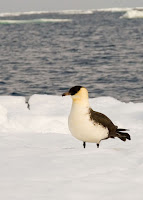POMARINE JAEGER
POMARINE JAEGER – (Stercorarius pomarinus) – (See images below)
DESCRIPTION: The Pomarine Jaeger (or Pomarine Skua) has two morphs, a light one and a dark one. Most of the breeding adults have the light morph, i.e. have white neck, breast and under parts, with a white patch near the wing tips. The head and top parts are dark brown. The dark morph is dark brown with a whitish neckband. The central tail feathers (streamers) are longer during the breeding season. The bill is long and pinkish with a dark tip, and the upper mandible ends with a hook. The legs and webbed feet are black. Juveniles are dark brown on top, with mottled brown and white under parts, but their plumage can vary. Sexes are similar. This bird’s length is around 55 cm (22 inches).
VOICE: https://www.xeno-canto.org/species/Stercorarius-pomarinus
NAME: The English name ‘Jaeger’ comes from German and means ‘hunter’. The Latin genus name ‘Stercorarius’ refers to ‘dung’, as this species goes after fish scraps (offal) from fishing vessels. The name ‘Pomarine’ is from ancient Greek and refers to the growth at the base of the bill during breeding season.
HABITAT: Open seas, along the coasts. The jaegers can be found at the junction of ocean currents and upwellings that bring fish close to the surface.
DIET: Pomarine jaegers feed heavily on rodents during their breeding season. Their reproduction cycles match rodent population levels. Nonbreeding birds have a more varied diet that includes small birds, insects, and carrion. When at sea, they eat mostly fish, some of which are stolen from other seabirds, including gulls larger than themselves.
NESTING: The breeding cycle of this species varies with the lemming populations. The nest is a shallow depression in the open tundra, lightly lined with plant material. About two dark green eggs are laid, which are incubated by both parents, who also both feed the chicks.
DISTRIBUTION: This seabird’s breeding range covers the high Arctic around the globe. In the winter it can be found in the tropical seas in the Caribbean, off East Africa, in the Indian Ocean and as far south as off the east coast of Australia. Some also visit the coastal waters of Hawaii.
Distribution map: https://en.wikipedia.org/wiki/Pomarine_jaeger#/media/File:StercorariusPomarinusIUCNver2018_2.png
ON PEI: The pomarine jaeger does not breed on Prince Edward Island, and its occurrence on the island is rare or uncommon in the fall, during its migration. There were two confirmed sightings at East Point in October 2005.
CONSERVATION: There is little known about the population trends of the pomarine jaeger other than fluctuations related to lemming reproduction cycles. At the present time it is not considered at risk.
NOTES: The pomarine jaeger is a pelagic seabird with some kleptoparasitic tendencies (if given a chance). It competes with the Snowy Owl on its breeding territory for high populations of lemmings.
SIMILAR SPECIES: Parasitic Jaeger, Long-tailed Jaeger
REFERENCES: https://www.audubon.org/field-guide/bird/pomarine-jaeger
https://en.wikipedia.org/wiki/Pomarine_jaeger
http://www.birdweb.org/birdweb/bird/pomarine_jaeger
http://www.arkive.org/pomarine-jaeger/stercorarius-pomarinus/
https://www.allaboutbirds.org/guide/Pomarine_Jaeger/overview
http://nzbirdsonline.org.nz/species/pomarine-skua
DESCRIPTION: The Pomarine Jaeger (or Pomarine Skua) has two morphs, a light one and a dark one. Most of the breeding adults have the light morph, i.e. have white neck, breast and under parts, with a white patch near the wing tips. The head and top parts are dark brown. The dark morph is dark brown with a whitish neckband. The central tail feathers (streamers) are longer during the breeding season. The bill is long and pinkish with a dark tip, and the upper mandible ends with a hook. The legs and webbed feet are black. Juveniles are dark brown on top, with mottled brown and white under parts, but their plumage can vary. Sexes are similar. This bird’s length is around 55 cm (22 inches).
VOICE: https://www.xeno-canto.org/species/Stercorarius-pomarinus
NAME: The English name ‘Jaeger’ comes from German and means ‘hunter’. The Latin genus name ‘Stercorarius’ refers to ‘dung’, as this species goes after fish scraps (offal) from fishing vessels. The name ‘Pomarine’ is from ancient Greek and refers to the growth at the base of the bill during breeding season.
HABITAT: Open seas, along the coasts. The jaegers can be found at the junction of ocean currents and upwellings that bring fish close to the surface.
DIET: Pomarine jaegers feed heavily on rodents during their breeding season. Their reproduction cycles match rodent population levels. Nonbreeding birds have a more varied diet that includes small birds, insects, and carrion. When at sea, they eat mostly fish, some of which are stolen from other seabirds, including gulls larger than themselves.
NESTING: The breeding cycle of this species varies with the lemming populations. The nest is a shallow depression in the open tundra, lightly lined with plant material. About two dark green eggs are laid, which are incubated by both parents, who also both feed the chicks.
DISTRIBUTION: This seabird’s breeding range covers the high Arctic around the globe. In the winter it can be found in the tropical seas in the Caribbean, off East Africa, in the Indian Ocean and as far south as off the east coast of Australia. Some also visit the coastal waters of Hawaii.
Distribution map: https://en.wikipedia.org/wiki/Pomarine_jaeger#/media/File:StercorariusPomarinusIUCNver2018_2.png
ON PEI: The pomarine jaeger does not breed on Prince Edward Island, and its occurrence on the island is rare or uncommon in the fall, during its migration. There were two confirmed sightings at East Point in October 2005.
CONSERVATION: There is little known about the population trends of the pomarine jaeger other than fluctuations related to lemming reproduction cycles. At the present time it is not considered at risk.
NOTES: The pomarine jaeger is a pelagic seabird with some kleptoparasitic tendencies (if given a chance). It competes with the Snowy Owl on its breeding territory for high populations of lemmings.
SIMILAR SPECIES: Parasitic Jaeger, Long-tailed Jaeger
REFERENCES: https://www.audubon.org/field-guide/bird/pomarine-jaeger
https://en.wikipedia.org/wiki/Pomarine_jaeger
http://www.birdweb.org/birdweb/bird/pomarine_jaeger
http://www.arkive.org/pomarine-jaeger/stercorarius-pomarinus/
https://www.allaboutbirds.org/guide/Pomarine_Jaeger/overview
http://nzbirdsonline.org.nz/species/pomarine-skua
 |
| Pomarine Jaeger, Jomilo75 |
 |
| Pomarine jaeger, dark morph, NC by Patrick Coin |
 |
| Pomarine jaeger dark morph, India Feb. 2008, by Mike Prince |